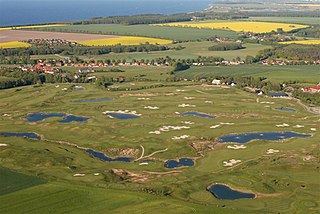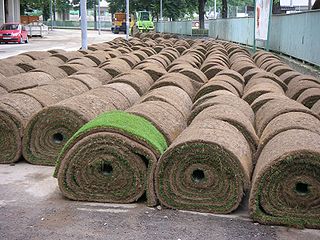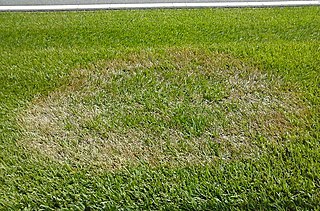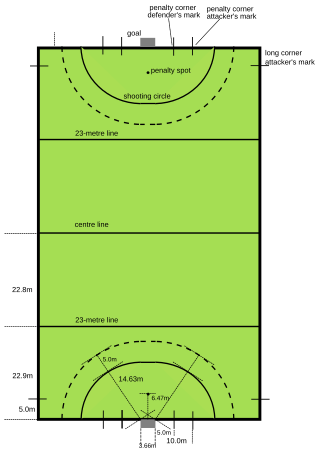
A tennis court is the venue where the sport of tennis is played. It is a firm rectangular surface with a low net stretched across the centre. The same surface can be used to play both doubles and singles matches. A variety of surfaces can be used to create a tennis court, each with its own characteristics which affect the playing style of the game.

Fusarium patch is a disease in turf grass settings also called pink snow mold or Microdochium patch. In many cool season grass species in North America, it is caused by the fungus Microdochium nivale. The white-pink mycelium on infected leaf blades is a distinguishing characteristic of the Microdochium nivale pathogen. Fusarium patch is considered economically important in the turf grass industry because of its tendency to cause significant injury to golf greens, thereby decreasing putting surface quality. Dissimilar from other snow molds, such as gray snow mold, Microdochium nivale does not need snow cover to cause widespread infection.

Organic lawn management or organic turf management or organic land care or organic landscaping is the practice of establishing and caring for an athletic turf field or garden lawn and landscape using organic horticulture, without the use of manufactured inputs such as synthetic pesticides or artificial fertilizers. It is a component of organic land care and organic sustainable landscaping which adapt the principles and methods of sustainable gardening and organic farming to the care of lawns and gardens.

A golf course is the grounds on which the sport of golf is played. It consists of a series of holes, each consisting of a tee box, a fairway, the rough and other hazards, and a green with a cylindrical hole in the ground, known as a "cup". The cup holds a flagstick, known as a "pin". A standard round of golf consists of 18 holes, and as such most courses contain 18 distinct holes; however, there are many 9-hole courses and some that have holes with shared fairways or greens. There are also courses with a non-standard number of holes, such as 12 or 14.

Permeable paving surfaces are made of either a porous material that enables stormwater to flow through it or nonporous blocks spaced so that water can flow between the gaps. Permeable paving can also include a variety of surfacing techniques for roads, parking lots, and pedestrian walkways. Permeable pavement surfaces may be composed of; pervious concrete, porous asphalt, paving stones, or interlocking pavers. Unlike traditional impervious paving materials such as concrete and asphalt, permeable paving systems allow stormwater to percolate and infiltrate through the pavement and into the aggregate layers and/or soil below. In addition to reducing surface runoff, permeable paving systems can trap suspended solids, thereby filtering pollutants from stormwater.

Sod, also known as turf, is the upper layer of soil with the grass growing on it that is often harvested into rolls.

Artificial turf is a surface of synthetic fibers made to look like natural grass, used in sports arenas, residential lawns and commercial applications that traditionally use grass. It is much more durable than grass and easily maintained without irrigation or trimming, although periodic cleaning is required. Stadiums that are substantially covered and/or at high latitudes often use artificial turf, as they typically lack enough sunlight for photosynthesis and substitutes for solar radiation are prohibitively expensive and energy-intensive. Disadvantages include increased risk of injury especially when used in athletic competition, as well as health and environmental concerns about the petroleum and toxic chemicals used in its manufacture.

A hardcourt is a surface or floor on which a sport is played, most usually in reference to tennis courts. It is typically made of rigid materials such as asphalt or concrete, and covered with acrylic resins to seal the surface and mark the playing lines, while providing some cushioning. Historically, hardwood surfaces were also in use in indoor settings, similar to an indoor basketball court, but these surfaces are rare now.

A retention basin, sometimes called a retention pond,wet detention basin, or storm water management pond (SWMP), is an artificial pond with vegetation around the perimeter and a permanent pool of water in its design. It is used to manage stormwater runoff, for protection against flooding, for erosion control, and to serve as an artificial wetland and improve the water quality in adjacent bodies of water.

A pitch or a sports ground is an outdoor playing area for various sports. The term pitch is most commonly used in British English, while the comparable term in Australian, American and Canadian English is playing field or sports field.
Pythium volutum is a plant pathogen infecting wheat, barley, and turfgrass. It is known to be sensitive to some of the compounds typically present in selective media commonly used for isolating Pythium spp., so isolation may require alternative methods.

A greenskeeper is a person responsible for the upkeep of a golf course. Their duties include all horticultural practices, as well as the setting of flag-sticks and marking of hazards. Other responsibilities typically include raking bunkers, watering plants, repairing divots, trimming tee boxes, and mowing the course. Greenskeepers often work under the direction of a golf course superintendent.
Sand-based athletic fields are sports turf playing fields constructed on top of sand surfaces. It is important that turf managers select the most suitable type of sand when constructing these fields, as sands with different shapes offer varied pros and cons. Regular maintenance of sand-based athletic fields is just as important as the initial construction of the field. As water and other aqueous solutions are added, a layer of thatch may accumulate on the surface of the turf. There are different ways to manage this level of thatch, however the most common are aeration and vertical mowing.

STRI, formerly the Sports Turf Research Institute, is a consultancy for the development of sports surfaces, based in St Ives, Bingley, West Yorkshire, England, providing advice on the research, design, construction and management of both natural and artificial sports fields of play around the world.
Magnaporthe poae is an ascomycete fungus which causes the turfgrass disease commonly known as summer patch, or Poa patch. The disease occurs mostly on Kentucky bluegrass (Poa pratensis), Fescues (Festuca sp.), and on Annual bluegrass (Poa annua). Bentgrass may also become infected but shows very few symptoms and quickly recovers. Summer Patch will usually become noticeable between June and September, although small signs can appear at any time but are not noticeable because the turfgrass can recover quickly.

Brown patch is a common turfgrass fungal disease that is caused by species in the genus Rhizoctonia, usually Rhizoctonia solani. Brown patch can be found in all of the cool season turfgrasses found in the United States. Brown patch is most devastating to: Bentgrass, ryegrass, Annual bluegrass, and Tall fescue. Brown patch is also found in Kentucky bluegrass and Fine fescue but this is rare or does minimal damage. Brown patch is known as a foliar disease, so it does not have any effect on the crown or roots of the turf plant.
Pythiumdisease, also known as "Pythiumblight," "cottony blight," or "grease spot," is a highly destructive turfgrass disease caused by several different Pythium species. All naturally cultivated cool-season turfgrasses are susceptible to Pythium and if conditions are favorable to Pythium it can destroy a whole turfgrass stand in a few days or less. Pythium favors hot and very humid weather and will usually develop in low areas or swales in the turfgrass.

A hockey pitch is the playing surface for the game of field hockey. Historically, the game was played on natural turf (grass) and nowadays it is predominantly played on an artificial turf. The transition to artificial pitches came during the 1970s and was made mandatory for major competitions in 1976. All the lines, markings and goal specifications are outlined by the International Hockey Federation in "The Rules of Hockey".

A line marker is a device or machine with which lines or markings are drawn on a sports field or pitch. They were originally developed to mark out lawn tennis courts on grass, but later also became used in many other sports with outdoor pitches. The marked lines are often white, but may be any color. A variety of devices have been used, some of them now being robotically controlled.
Redgra, sometimes styled as RedGra, Red-Gra, or generically as redgra, is the brand name of an all-weather surfacing material primarily composed of red clay and fine limestone gravel. It is used on baseball diamonds, running tracks and long jump run-ups, and hard-surface association football, netball, cricket, and field hockey pitches in the United Kingdom.
















